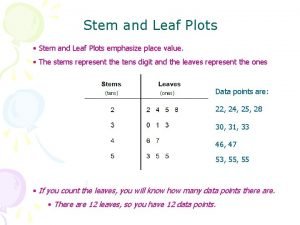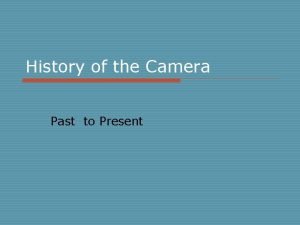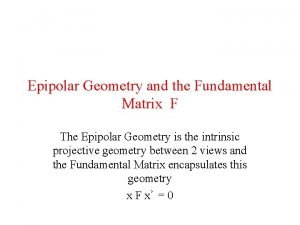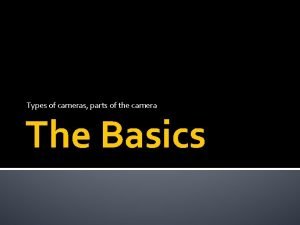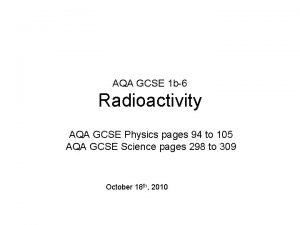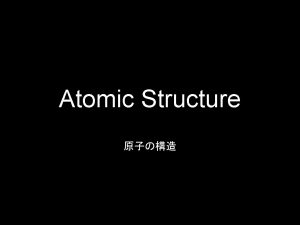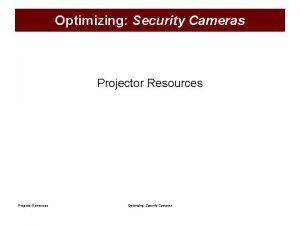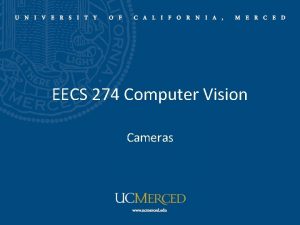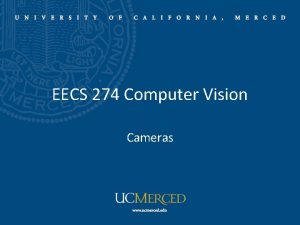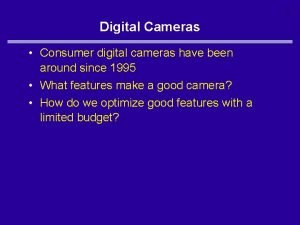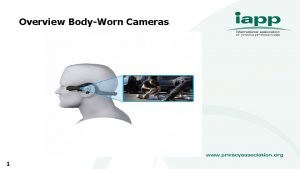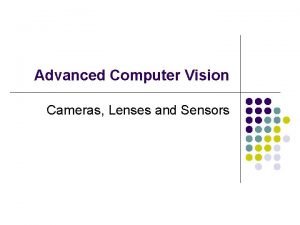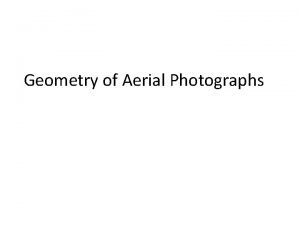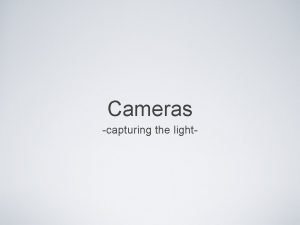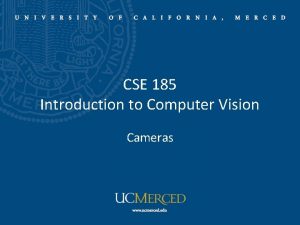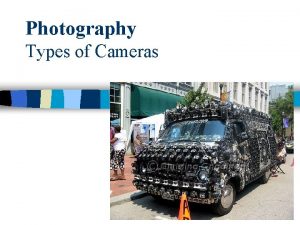Cameras 1 Cameras Cameras 2 Introductory Question n
















- Slides: 16

Cameras 1 Cameras

Cameras 2 Introductory Question n If you’re building a camera and want to make a larger image (a telephoto lens) you should: A. increase the diameter of the lens decrease the diameter of the lens increase the curvature of the lens decrease the curvature of the lens B. C. D.

Cameras 3 Observations about Cameras They record a scene on an image sensor n Good cameras must focus, cheap ones don’t n They sometimes have zoom lenses n Some cameras have bigger lenses than others n They have ratings like focal length and fnumber n

Cameras 4 Light from an Object An illuminated object reflects or scatters light n You see object via reflected or scattered light n The object’s light forms diffuse illumination n You can’t tell what object looks like from this diffuse illumination n

Cameras 5 Converging Lenses n A converging lens bends light rays via refraction Light rays converge n Rays from a common point on an object converge to a common point on far side of the lens n

Cameras 6 Real Images An image forms in space on far side of the lens n The image is a pattern of light in space that exactly resembles the object, except for size and orientation n The image is “real” – you can put your hand in it n

Cameras 7 Lenses and Image Sensor Film records the pattern of light it’s exposed to n If you put film in a real image, it will record a pattern of light resembling the object n For a good photograph, the real image should be sharply focused on the image sensor and have the right size n

Cameras 8 Focusing Light reaching lens from an object is diverging n The nearer the object, the more its light diverges n Converging lens has trouble with diverging light n Real image of nearby object forms farther from lens n Real image of distant object forms closer to lens n

Cameras 9 Focal Length n Focal length measures lens’ converging ability Long focal length: weak lens, long image distance n Short focal length: strong lens, short image distance n n Larger the object distance, then bigger image Long focal length: big images n Short focal length: small images n

Cameras 10 Lens Diameter n Larger lens converges more light n brighter image n focus becomes more critical n less depth of focus n n Smaller lens dimmer image n focus becomes less critical n more depth of focus n

Cameras 11 Introductory Question (revisited) n If you’re building a camera and want to make a larger image (a telephoto lens) you should: A. increase the diameter of the lens decrease the diameter of the lens increase the curvature of the lens decrease the curvature of the lens B. C. D.

Cameras 12 Wide Angle vs Telephoto n Wide angle lens Strong to converge rays quickly and focus close n Bright, small image forms near lens n Small diameter lenses are usually adequate n n Telephoto lens Weak to converge rays slowly and focus far n Dim, large image forms far from lens n Large diameter lenses are usually necessary n

Cameras 13 Aperture or f-number Aperture characterizes the diameter of the lens n F-number is focal length over lens diameter n Large f-number n Dim image n Large depth of field/focus (focus is forgiving) n n Small f-number Bright image n Small depth of field/focus (focus is critical) n

Cameras 14 Lens Flaws n Dispersion different colors focus differently Use low-dispersion glass (fluoride glasses) n Use multi-piece lenses or “achromats” n n Reflections fog in photographic images n Use antireflection coatings

Cameras 15 Eyes n Our eyes have lenses and an image sensor n Unlike in cameras, eyes focus by changing the focal length of the lens.

Cameras 18 Digital Cameras Instead of film, use CCD imaging chip n Chip is divided into tiny squares or pixels n Photon causes charge transfer in pixel n After exposure, pixels retain charge image n Charge is shifted out of pixels using MOSFETs n Camera obtains and saves image n
 Level 2 costa questions examples
Level 2 costa questions examples Stem and leaf diagram example
Stem and leaf diagram example Camera past tense
Camera past tense Jacobs cameras
Jacobs cameras Speed detection of moving vehicle
Speed detection of moving vehicle Fundamental matrix
Fundamental matrix Pinhole camera advantages and disadvantages
Pinhole camera advantages and disadvantages How to calculate half life physics
How to calculate half life physics Factor-relating questions examples
Factor-relating questions examples Question word simple present
Question word simple present Direct indirect question sentences
Direct indirect question sentences Closed question example
Closed question example Supporting questions for a compelling question
Supporting questions for a compelling question Contoh open question dan close question
Contoh open question dan close question Whats a compelling question
Whats a compelling question The canterbury tales setting
The canterbury tales setting Examples of introduction paragraph
Examples of introduction paragraph

